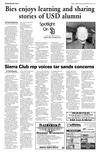4



04 Broadcaster Press
June 5, 2012 www.broadcasteronline.com
Bies enjoys learning and sharing
stories of USD alumni
By Travis Gulbrandson
travis.gulbrandson@plaintalk.net
As communications
coordinator for the USD
Alumni Association, it is
the job of Jarett C. Bies to
keep USD grads abreast of
university happenings, as
well as alumni updates.
The lead writer for the
association’s biannual
magazine, The South
Dakotan, also releases a
monthly electronic
newsletter, The Coyote
Connection.
“I really enjoy learning
and sharing the stories
about the alumni,” Bies
said. “We are able to bring
the greater global stories of
UDS coyote alumni around
the world back to the
university and to the
alumni community, and at
the same time keep alumni
informed on things here in
Vermillion.”
In addition to his work
with the publications, Bies
does “just about anything
else on the
communications front,”
from social media to
electronic media to press
releases.
“I also help to recruit
people to organize events,
recruit new members to
the alumni association,
answer questions and
provide support to our
four-person team,” he said.
This year should be very
exciting, he added, since it
is USD’s 150th anniversary.
“It’s been a lot of fun
sharing the historic story of
the sate’s flagship
university,” Bies said. “I had
the opportunity to
interview alums as far back
as the 1930s to the present.
It’s been exciting to
celebrate that milestone …
and we’re taking the energy
from that celebration and
going forward into the next
150 years with a lot of
events and increased
outreach so that we can
Spotlight
On
keep alumni connected
wherever they happen to
be in the world.”
A native of Sioux Falls,
Bies graduated from USD
in 1994.
Before coming back to
work there in November
2011, he was employed as a
social media editor in
Minneapolis and worked as
a writer for the South
Dakota State Extension
Service.
He and his wife Laura
live in Vermillion with
their three cats.
When he’s not working,
Bies said his passion is
kayaking. In fact, he is one
of the founders of the
South Dakota Kayak
Challenge, which just took
place last weekend.
“This is our third year,
but the second year we
were actually able to have
the event,” Bies said. “With
the flooding last year, we
had to cancel it. But we had
our best year yet, with 170
people signed up for the
event, 156 that took part
and 103 who made it to the
finish line in Sioux City.”
Bies described his role
with the event as one
involving marking,
communications and
organization.
He said he was glad to
have the opportunity.
“That was a really
exciting weekend, and it
was really fun to host so
many people traveling
from as far away as Texas
and North Carolina to
come here and see the
Missouri River,” he said.
Sierra Club rep voices tar sands concerns
By Travis Gulbrandson
travis.gulbrandson@plaintalk.net
Approximately 1.5
million barrels of tar
sands crude oil is
coming into the United
States per day.
If the TransCanada
Keystone I and XL
pipelines are completed
as proposed, that total
could be increased to 2.5
million barrels by 2020
and 15 million barrels by
2030.
This poses multiple
environmental concerns
which need to be
addressed sooner rather
than later, said Dr. James
Heisinger, University of
South Dakota professor
emeritus and chair of the
state chapter of the
Sierra Club.
Heisinger spoke about
the issue recently during
a presentation to the
local Sierra Club at the
WH Over Museum.
One issue concerns
the composition of the
tar sands themselves.
“The ‘black gold’ of
the tar sands is bitumen,
and it’s like asphalt,”
Heisinger said. “You’re
going to have to liquefy
it in some way. It’s not
just like asphalt, it’s also
got sand in it, so it has to
be liquefied, separated
from the sand. That
requires steam.
“The steam means
you have to use energy
to heat the water. And
then, when the water
separates from the sand
and the bitumen you
have to dispose of the
water in some
reasonable way because
it’s toxic. So it’s
problematic,” he said.
The water is stored in
tailing lakes up to 25
miles across which don’t
evaporate very fast.
“Not to worry,”
Heisinger said. “There
are levees surrounding
these big toxic pools. …
“There are two types
of levees,” he continued.
“The ones that have
been breached, and the
ones that will be
breached. So it’s a
problem.”
Once the sand is
removed from the
bitumen, it remains
similar to asphalt, and
thus needs to be treated
with a diluent called
dilbit.
“You can imagine …
that great quantities of
greenhouse gasses have
to be produced in this
process, and indeed they
are,” Heisinger said.
There also are
problems with the
pipelines, he said.
Keystone I already has
had more than 30 leaks,
14 of which occurred in
the United States.
One of these leaks
dumped more than
840,000 gallons – about
20,000 barrels – of tar
sands into the
Kalamazoo River,
requiring a $750 million
clean-up, Heisinger said.
A smaller leak –
63,000 gallons –
occurred in the
Yellowstone River, he
said.
A unique problem
arose when the diluent
was placed in the icy
water, Heisinger said.
Because the diluent was
lighter than the water,
the bitumen separated
from it and just sunk.
Clean-up cost $135
million, with less than 1
percent recovered, he
said.
Because of its abrasive
nature, bitumen has to be
pumped at high pressure,
which has caused some
of the pipelines it to
explode, Heisinger said.
One such case
happened in Minnesota
in 2006, leaving two
workers dead.
“Some of these
pipelines … really
weren’t designed for
bitumen,” Heisinger said.
“They’re old pipelines
that have had pump
houses added. We really
haven’t developed safety
and spill response
standards beyond the
conventional oil pipeline.
“So this is a real
struggle, something we’re
going to have to do if
we’re pumping viscous
oil at high pressure,” he
said.
At the time the
pipelines were proposed,
many people were not
thinking with an eye
toward environmental
consequences, Heisinger
said.
When Keystone I was
first proposed, the
United States “was deep
into Afghanistan and
Iraq,” he said.
“It was hard to oppose
anything like that,” he
said. “It was hard to say,
‘Well, gee, you shouldn’t
be bringing oil down
from Canada, dirty oil,
and refining it.’ People
were thinking about
military and security.
That’s very different from
2008, which is when the
XL was introduced to the
public. At that time,
though, many of us were
worried about jobs.”
That said, the
information cited by
Keystone regarding job
creation is not quite what
it appears, Heisinger
said.
“They’ve loaded the
deck,” he said. “In
TransCanada’s 2008
presidential permit
application, they said
there would be 3,5004,200 construction
personnel. They didn’t
say that most of them
would be Canadian. But
most of them would be
Canadian.”
Keystone said an
additional 20,000 jobs
would come from
building the actual
pipeline, as opposed to
installing it.
“Somebody’s got to
build the pipeline, but
what they didn’t say was
that the steel comes from
Poland, and the pipelines
are constructed, some of
them, in India, and so
foreign labor is utilized,”
Heisinger said.
He added that
according to the Cornell
University Global Labor
Institute, only 20
permanent jobs will be
created on the pipeline
and be constituted by
people actually manning
the pump houses.
“The XL will not claim
a major source of U.S.
jobs, nor will it claim any
role at all in putting
Americans back to work,”
the Cornell report said.
Additionally, there is
no guarantee that the
pipelines will have a
positive effect on the
price of fuel in the U.S.
According to the report,
it actually could
contribute to a rise in gas
prices.
For these and other
reasons, Heisinger said
people need to get
involved to find a
solution to the issues
soon.
“It’s going to be harder
and harder for our nation
to do anything about this
… if we let it progress,”
he said.
To view the Cornell
University Global Labor
Institute’s report on the
Keystone XL pipeline,
visit
http://www.ilr.cornell.ed
u/globallaborinstitute/re
search/upload/GLI_Keys
toneXL_Reportpdf.pdf.
WANTED
Buying all types of SCRAP IRON
Farm Machinery • Cars & Trucks
References Available • Top Market Prices Paid
Home: 402-945-1512 • Cell: 402-533-3640
K&K Iron & Metal
Patricia Curry: 605-661-2860
Andy Curry: 605-261-1202
Archie Dunham: 605-366-4625
Also see us at
Siouxlandhomes.com
www.dunhamcompany.com
Virtual Tours
Elk Point, SD
OAKWOOD APARTMENTS
• AFFORDABLE RENT
•
•
•
•
•
•
•
ADJUSTMENT FOR YOUR INCOME
LARGE 2 AND 3 BEDROOM RENTAL UNITS
STOVE, REFRIGERATOR & AIR CONDITIONING
OFF-STREET PARKING AND PLUG-INS
UTILITIES INCLUDED
ON-SITE COIN LAUNDRY
PLAYGROUND EQUIPMENT & SAND BOX
3 BLOCKS FROM CAMPUS
CALL NIKKI OR DAVE
(605) 624-9557
402 E. Rose Street – $79,950
2-bedroom, 1-bath, many
updates in kitchen and bath.
Oversized attached garage w/
work bench. Kitchen appliances
and stacked washer and dryer
included.
2008 Side by Side Duplex – $209,000
301 & 303 S. Pearl St.
Great Business Opportunity: live on
one side, rent the other. 2 units each:
2 bedroom, 1 bath 2 stall. Each unit
with stainless steel stove, refrig,
dishwasher. Washer/dryer included.
Professionally landscaped.
203 Lexington St. – $151,500
2007 split home. 4 bedrooms,
1 bath. Stainless Steel
Appliances stay. New floor in
kitchen, new faucets. Lower
walk out level future family
room, future 2nd full bath, all
set to go. Easy access to I29,
school and down town.
2007 Country Club Drive – $164,900
Top to walk out lower level
finish! 1909 sf: 3 bed, 3 bath,
April 2012 new carpet,
fireplace, fenced yard w/garden
shed. Kitchen appliances stay,
heated garage w/GDO. Shingles
2010. Close to school bus stop.
706 E. Clay Street – $129,900
Nice home has been well cared
for and has many recent
updates. Call for your showing
today!! 24 hour notice
preferred. This home qualifies
for a rural development loan,
with no downpayment!
10% OFF
COUNTRY CLUB ESTATES/
RESIDENTAL LOTS IN ELK
POINT
















 Previous Page
Previous Page






